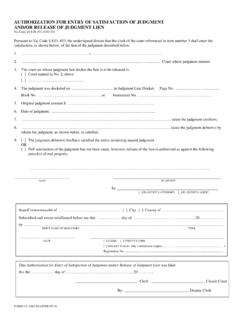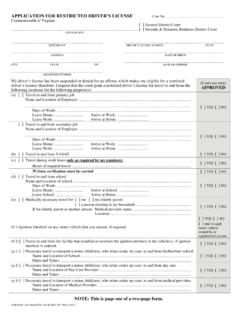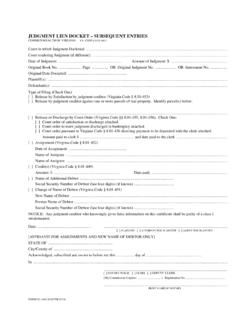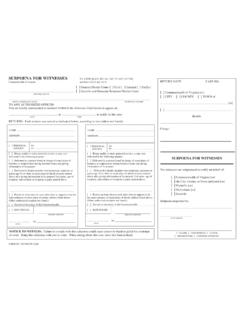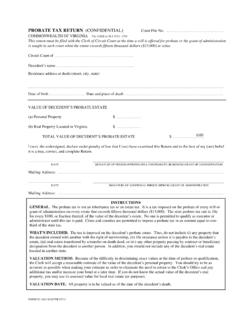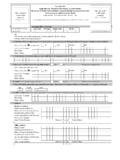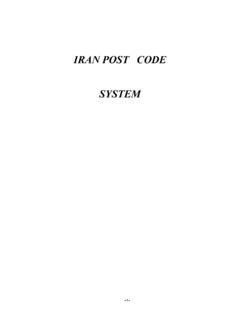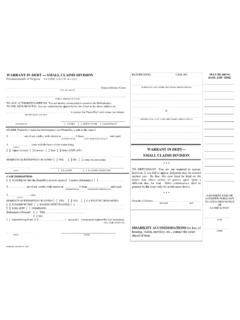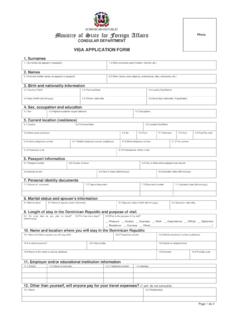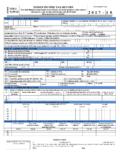Transcription of General District Manual - Chapter 3 - Judiciary of …
1 General District COURT Manual CRIMINAL CASE PROCEDURES PAGE 3-1 Office of the Executive Secretary Department of Judicial Services Rev: 7/17 Chapter 3 - CRIMINAL CASE PROCEDURES I. INTRODUCTION Criminal cases are proceedings brought by the Commonwealth (or a locality ) for offenses violating state law or local ordinances. The two categories of crimes are felonies and misdemeanors. Felonies, which can only be tried in circuit court, are punishable by fine or imprisonment in a penitentiary for one year or more or both a fine and term of imprisonment. Examples of felonies include murder, malicious or unlawful wounding (felonious assault), grand larceny, and rape. The District courts do not have jurisdiction to adjudicate felony cases, but they do have jurisdiction to conduct preliminary hearings in felony cases, in order to determine whether there is sufficient evidence to justify holding the defendant for a grand jury hearing and trial in circuit court.
2 Misdemeanors are punishable by a fine of up to $2,500 or a sentence not exceeding twelve months in jail, or a combination of a fine and a jail sentence. Examples of misdemeanors include simple assault, public intoxication, petit larceny, and shoplifting. The burden of proof in all criminal cases is beyond a reasonable doubt; that is, the evidence must be so completely convincing toward the guilt of the defendant that there is no reasonable doubt of the defendant s guilt. The District courts do not conduct jury trials; a judge hears all cases. Jury trials are held only in circuit court, as provided by the Virginia Constitution. These procedures apply to cases in which adults are charged with committing criminal offenses, regardless of whether the case is tried in a General District court or in a juvenile and domestic relations District court.
3 Normally, these provisions do not govern trials of juveniles charged with being delinquent unless the juvenile was previously tried and convicted in a circuit court as an adult under Va. Code et seq., and commits a subsequent criminal offense. Va. Code Of special consideration in criminal cases are the defendant's rights under the Sixth Amendment to the Constitution of the United States. The Sixth Amendment ensures the right to a speedy trial, to trial by jury, to be informed of the charge, to confront one s accuser, to subpoena witnesses in one s favor, and to have the assistance of a lawyer. The presentation of criminal case procedures begins with a narrative description of the basic criminal case process. The narrative describes the flowchart of the criminal case process. Following the narrative, the detailed procedures are presented beginning with case initiation and ending with case closure.
4 General District COURT Manual CRIMINAL CASE PROCEDURES PAGE 3-2 Office of the Executive Secretary Department of Judicial Services Rev: 7/17 II. NARRATIVE DESCRIPTION The criminal case process is generally initiated when a criminal offense is committed and reported to the police. The police or other law officer conducts an investigation to determine the facts of the case, identify likely suspects, and locate witnesses to the crime. In the course of the investigation, the officer may request issuance of District court form DC-339, SEARCH WARRANT by presenting a DC-338, AFFIDAVIT FOR SEARCH WARRANT to a judge, clerk, or magistrate, who then conducts a probable cause hearing on the request and will issue the search warrant if probable cause is found. A judge, magistrate, or person authorized to issue criminal warrants may also issue District court form DC-341, Search Warrant for Tracking Device, which is used to permit the installation and use of a tracking device by presenting District court form DC-340, AFFIDAVIT FOR SEARCH WARRANT FOR TRACKING DEVICE.
5 Search warrants are not docketed in the General District court. It is recommended that the clerk not retain a copy of either the affidavit or search warrant. The clerk should, seal the document in a confidential envelope and forward immediately to the circuit court. Offenses for which a search warrant to withdraw blood may be issued is to be given priority over matters not involving imminent risk to another s health or safety before such judge or magistrate. These offenses include DUI s, commercial DUI s, watercraft DUI s, underage DUI s and underage watercraft DUI s as well as offenses of Va. Code , driving after forfeiture of license. When the officer has identified the probable offender(s), the officer either issues a VIRGINIA UNIFORM SUMMONS or requests a District court form DC-312, WARRANT OF ARREST - FELONY, DC-314, WARRANT OF ARREST - MISDEMEANOR (STATE), DC-315, WARRANT OF ARREST MISDEMEANOR (LOCAL) or DC-319, SUMMONS from a judicial officer, usually a magistrate.
6 A VIRGINIA UNIFORM SUMMONS is issued whenever a criminal misdemeanor occurs in the officer's presence, unless the defendant is charged with a jailable misdemeanor and the arresting officer believes that the defendant will disregard the summons or is likely to cause harm to himself or refuses to discontinue the unlawful act, or the defendant is charged with violating Va. Code (failing to disperse at the scene of a riot) or (drunk in public). If a VIRGINIA UNIFORM SUMMONS is issued, the officer takes the defendant into custody. The officer will release him if he signs the promise to appear section on the VIRGINIA UNIFORM SUMMONS. If a VIRGINIA UNIFORM SUMMONS is not issued or the defendant refuses to sign the promise to appear, the officer takes the defendant before the magistrate who determines whether there is probable cause to believe that the defendant committed the offense.
7 The judicial officer determines whether there is probable cause to believe that the individual may have committed the offense before issuing a warrant or summons. If probable cause is found, a District court form DC-312, WARRANT OF ARREST - FELONY, DC-314, WARRANT OF ARREST - MISDEMEANOR (STATE), DC-315, WARRANT OF ARREST MISDEMEANOR (LOCAL) or, in misdemeanor cases, a DC-319, SUMMONS is issued by the magistrate, who then proceeds to set the date for the first court appearance. If not released on a summons, the magistrate determines bail, after which the defendant is released on General District COURT Manual CRIMINAL CASE PROCEDURES PAGE 3-3 Office of the Executive Secretary Department of Judicial Services Rev: 7/17 recognizance, with or without additional terms. If the defendant is unable to meet the terms set for release, the defendant is committed to jail, pending the first court appearance.
8 If a warrant was initially issued, the officer arrests the defendant and brings him before a magistrate to set the date for first court appearance and to determine bail, after which the defendant is released on bail or is committed to jail. If authorized by the magistrate issuing a misdemeanor warrant, the arresting officer may release the defendant pursuant to the summons section of a warrant or on a VIRGINIA UNIFORM SUMMONS. All case-related papers are sent to the clerk s office. Processing by the clerk s office begins with the receipt of the WARRANT OF ARREST, SUMMONS or VIRGINIA UNIFORM SUMMONS. The clerk s office assigns a case number to the warrant or summons, and indexes the case in the automated system. The clerk s office assembles all case-related documents, which are filed by court appearance date. Prior to the court date, the clerk s office retrieves all of the cases from the pending file for that court date and prints a docket via CMS, which contains all cases scheduled for a given day.
9 The docket and cases are sent to court on the scheduled trial date. For any defendant held in jail, the District court conducts an arraignment hearing on the next court day after arrest. At the arraignment, the court determines the status of the defendant s right to representation by an attorney, calls the defendant by name, reads the charges, asks for the defendant s plea, reviews the bail determination and sets the next court date, if he is not tried after arraignment. If two-way electronic video and audio communication is available for use by a District court for the conduct of a hearing to determine bail or to determine representation by counsel, the court shall use such communication in any such proceeding that would otherwise require the transportation of a person from outside the jurisdiction of the court in order to appear in person before the court.
10 For those not arraigned on the next court date, the court must determine the status of the defendant s right to representation by an attorney. If the defendant wishes the judge to appoint an attorney at public expense to represent him or her, the defendant must make a written request for such appointment and file District court form DC-333, FINANCIAL STATEMENT - ELIGIBILITY DETERMINATION FOR INDIGENT DEFENSE SERVICES with such request. In the alternative, the defendant may hire his own attorney or waive his right to be represented by an attorney. The court may try the defendant even if he or she has neither waived his or her right to legal representation nor hired an attorney, if the defendant is charged with a misdemeanor not punishable by a jail sentence, or if the judge states in writing before trial that, if the defendant is convicted, no jail sentence will be imposed.
